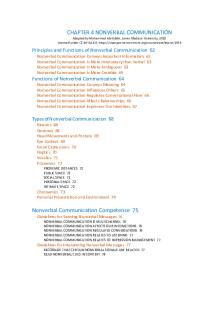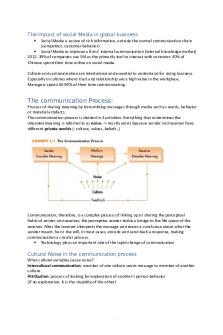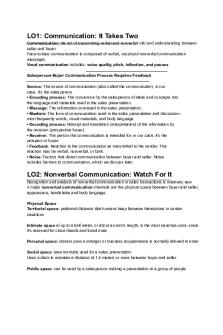Deresky H. Chapter 4 Communication PDF

| Title | Deresky H. Chapter 4 Communication |
|---|---|
| Author | Barbara Hofer |
| Course | Global Management |
| Institution | Aarhus Universitet |
| Pages | 6 |
| File Size | 319.7 KB |
| File Type | |
| Total Downloads | 75 |
| Total Views | 169 |
Summary
Download Deresky H. Chapter 4 Communication PDF
Description
The impact of social Media in global business
Social Media a source of rich information, outside the normal communication chain (competitor, customer behavior) Social Media to improve a firms’ internal communication (internal knowledge market) 2012: 39% of companies use SM as the primarily tool to interact with customer. 40% of Chinese spend their time online on social media. Culture and communication are intertwined and essential to understand for doing business. Especially in cultures where trust and relationship are a high value in the workplace. Managers spend 50-90% of their time communicating.
The communication Process: Process of sharing meaning by transmitting messages through media such as words, behavior or material artefacts. The communication process is divided in 3 activities. Everything that undermines the intended meaning is referred to as noise. -> mostly exists because sender and receiver have different private worlds (: culture, values, beliefs..)
Communication, therefore, is a complex process of linking up or sharing the perceptual fields of sender and receiver; the perceptive sender builds a bridge to the life space of the receiver. After the receiver interprets the message and draws a conclusion about what the sender meant, he or she will, in most cases, encode and send back a response, making communication a circular process. Technology plays an important role of the rapid change of communication
Cultural Noise in the communication process What cultural variables cause noise? Intercultural communication: member of one culture sends message to member of another culture Attribution: process of looking for explanation of another’s person behavior (if no explanation, it is the stupidity of the other)
The culture-communication link Underlying elements of culture that affect communication
Trust in communication Trust as a key element, but the meaning of it and how it developed varies along societies. Because if there is trust, cultural differences are easily overseen. Global guidelines to build trust: Create mutual benefit Improve predictability, resolve conflicts Create bonding trough regular socializing
The GLOBE Project Some general insights in the Globe project. Just introduction
Cultural variables in the communication process These variables are: attitudes; social organization; thought patterns; roles; language (spoken or written); nonverbal communication (including kinesic behavior, proxemics, paralanguage, and object language); and time. Example: Under the lens – Communication in India – Language, Customs, Culture and Etiquette. Page 154
Attitudes: Are often a noise in cross-cultural communication. Can lead to stereotyping: person assumes that every member of a society or subculture has the same characteristics or traits. Better: deal with each person as an individual
Social Organizations: Everybody belongs to a social organization, which can be based on religion, nation tribe, same profession. E.g. the Academy of Management
Thought patterns Reasoning processes vary around the world. (double line on the road 1. Forbidden to cross 2. To see show the middle of the street)
Roles The role of a manager is not the same around the world. What work is expected from the employees.
Language Spoken, written, body language (Pepsi: “Come alive with Pepsi” in German means “come out of the grave”) (more than 800 languages in Africa) (“Yes” in Asia means “I’ve heard you”, compliment in Algeria more like an indirect way of expressing a wish to have the same.) Needed is either a good command of the local language or competent interpretation.
Nonverbal communication =communication without words. People believe what they see over what they hear. 65-93% of communication is nonverbal. It can be categorized in 4 groups Kinesic behavior =Communication trough body movements, facial expressions & eye contact (where to look and how to stand, when talking to somebody) They are culturally specific and learned Most people can recognize basic emotions: anger, disgust, fear, happiness, sadness, surprise, and contempt. Example: Under the lens – Communication Italian Style. Page 162 Proxemics Deals with the influence of proximity and (personal and office-) space in communication space can communicate power (German: biggest office, French: in the center - control everything) high contact culture (Eastern Europe, Arabs, Indonesian, often in warmer regions) low contact culture (North America, Asia, north Europe, often in colder regions) correlation between Hofstede’s cultural variables: collectivism & individualism Example: Under the lens – How feng shui affects business page 163 Paralanguage How? The way something is said. Rate of speech, tone and inflection of voice, other noises, laughing, yawning. One important variable: silence (Americans get uncomfortable after 15-20 sec of silence, Chinese like to take 30sec to think about something before talking) Object language = material culture = how we communicate through material artifacts, whether architecture, office design and furniture, clothing, cars, or cosmetics. Material culture communicates what people hold as important.
Time People regard and use time differently. Monochronic culture: (Switzerland, Germany, United State) Time is lines. Past-presentfuture, one thing at a time Polychromic cultures: (Latin America, Arabs) focus on several things at once, change plans often, like to hold open meetings,
Context Affects meaning and interpration High context culture: (Asia, Middle East, Africa, Mediterranean) feelings and thoughts are not explicitly expressed – read between the lines instead, expect others to understand unarticulated moods, subtle gesture, they think people from low context cultures are too talkative and obvious, Low context culture: (Switzerland, Germany, Scandinavia, North America) more explicit Westerners focus more on the individual and therefore tend to view events as the result of specific agents, whereas Easterners view events in a broader and longer-term context.
Finding the balance is tricky: “Too much information leads people to feel they are being talked down to; too little information can mystify them or make them feel left out.”
Example: Management in action – Oriental Poker face page 167
Communication channels In addition to the variables related to the sender and receiver of a message, the variables linked to the channel itself and the context of the message must be taken into consideration. This includes fast or slow message information flow and the different types of channel. Information system: It is important to know where and how information originates and the speed at which it flows, both internally and externally. Context affects how information flows. In high context culture, it flows freely and easy, because of constant close contact. How to get the information? In Japan sometimes having a drink together can help – developing friendship. In America, this is easier. Also, Japanese avoid public disagreements at all costs. In cross-cultural negotiations, this last point is essential. Americans should develop patience, also when waiting for certain information. A list of communication differences between Japan and Amerika page 172
Information technology: going global and acting local Nowadays, thanks to the internet it is easy to quickly develop a presence in a new market. But these firms learn to adapt. (e-commerce, content management issues, resource planning) Global online strategy should be multi-local.
Managing cross-cultural communication S eps toward effective intercultural communication include the development of cultural sensitivity, careful encoding, selective transmission, careful decoding, and appropriate follow-up actions.
Developing cultural sensitivity It is the responsibility of the sender (firms, manager) to have awareness of their own cultural baggage. In other words, what kinds of behaviors does the message imply, and how will they be perceived by the receiver?
Careful encoding In translating his or her intended meaning into symbols for cross-cultural communication, the sender must use words, pictures, or gestures that are appropriate to the receiver’s frame of reference. Better: manager should learn the local language, not using sayings, talk slowly,
Selective transmission The type of medium chosen for the message depends on the nature of the message, its level of importance, the context and expectations of the receiver, the timing involved, and the need for personal interaction, among other factors. Find out how communication is transmitted in the local organization. (sms, whatsapp, email??) In addition, the cultural variables discussed earlier need to be considered: whether the receiver is from a high- or low-context culture, whether he or she is used to explicit or implicit communication, and what speed and routing of messages will be most effective. Also face to face is mostly better.
Careful decoding of feedback The main causes of incongruence are because (1) the receiver misinterprets the message, (2) the receiver encodes his or her return message incorrectly, or (3) the sender misinterprets the feedback. Also here: face to face is better.
Follow-up actions Managers communicate through both action and inaction. Behaviors that researchers indicate to be most important to intercultural communication effectiveness (ICE) are listed here, as reviewed by Ruben.
Concerning that, Managers should have 2 characteristics: openness & resilience These personality factors, along with the expatriate’s cultural and racial identity and the level of preparedness for change, comprise that person’s potential for adaptation.
Conclusion: Effective intercultural communication is a vital skill for international managers and domestic managers of multicultural workforces. Because miscommunication is much more likely to occur among people from different cultures. It is important to be alert to how culture is reflected in communication—in particular through the development of cultural sensitivity and an awareness of potential sources of cultural noise in the communication process. A successful international manager is thus attuned to these variables and is flexible enough to adjust his or her communication style. Cultural variables and the way culture is communicated underlie the processes of negotiation and decision making....
Similar Free PDFs

Chapter 4 Nonverbal Communication
- 19 Pages

Case01 facebook deresky im9e
- 9 Pages

4-H- Parameter - Notes
- 14 Pages

Communication and docs Chapter 4 emt
- 15 Pages

Lecture Notes 4 h
- 3 Pages

Communication - Apuntes 4
- 2 Pages

Chapter H homecoming summary
- 4 Pages

Written Communication 3&4
- 19 Pages

Assessment 4 Communication Report
- 11 Pages
Popular Institutions
- Tinajero National High School - Annex
- Politeknik Caltex Riau
- Yokohama City University
- SGT University
- University of Al-Qadisiyah
- Divine Word College of Vigan
- Techniek College Rotterdam
- Universidade de Santiago
- Universiti Teknologi MARA Cawangan Johor Kampus Pasir Gudang
- Poltekkes Kemenkes Yogyakarta
- Baguio City National High School
- Colegio san marcos
- preparatoria uno
- Centro de Bachillerato Tecnológico Industrial y de Servicios No. 107
- Dalian Maritime University
- Quang Trung Secondary School
- Colegio Tecnológico en Informática
- Corporación Regional de Educación Superior
- Grupo CEDVA
- Dar Al Uloom University
- Centro de Estudios Preuniversitarios de la Universidad Nacional de Ingeniería
- 上智大学
- Aakash International School, Nuna Majara
- San Felipe Neri Catholic School
- Kang Chiao International School - New Taipei City
- Misamis Occidental National High School
- Institución Educativa Escuela Normal Juan Ladrilleros
- Kolehiyo ng Pantukan
- Batanes State College
- Instituto Continental
- Sekolah Menengah Kejuruan Kesehatan Kaltara (Tarakan)
- Colegio de La Inmaculada Concepcion - Cebu






